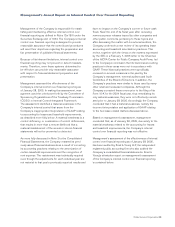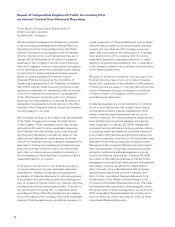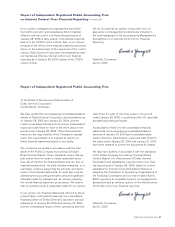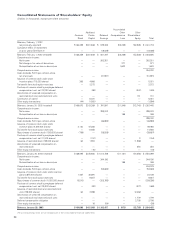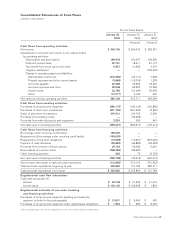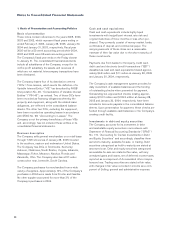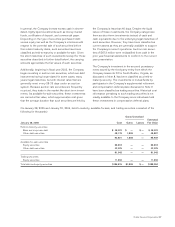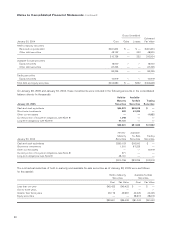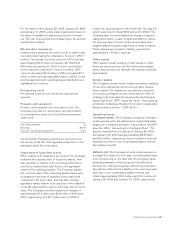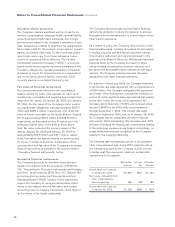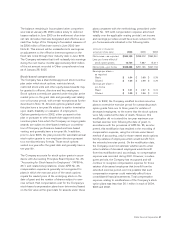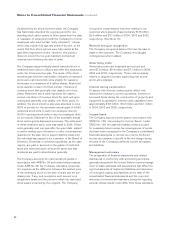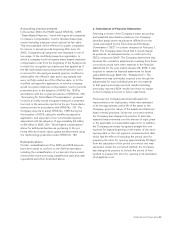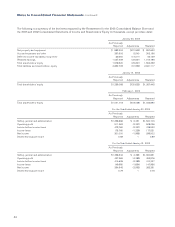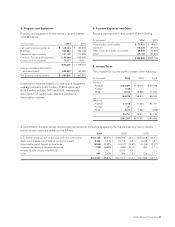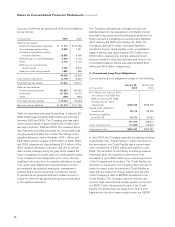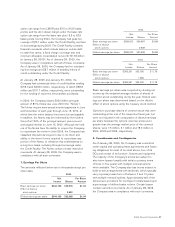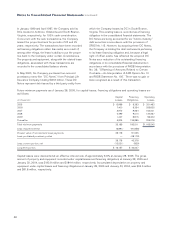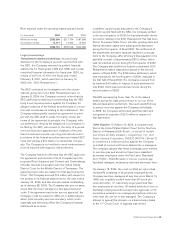Dollar General 2004 Annual Report Download - page 41
Download and view the complete annual report
Please find page 41 of the 2004 Dollar General annual report below. You can navigate through the pages in the report by either clicking on the pages listed below, or by using the keyword search tool below to find specific information within the annual report.
Dollar General Corporation 39
For the years ended January 28, 2005, January 30, 2004
and January 31, 2003, gross realized gains and losses on
the sales of available-for-sale securities were not mate-
rial. The cost of securities sold is based upon the specific
identification method.
Merchandise inventories
Inventories are stated at the lower of cost or market with
cost determined using the retail last-in, first-out (“LIFO”)
method. The excess of current cost over LIFO cost was
approximately $6.3 million at January 28, 2005 and
$6.5 million at January 30, 2004. Current cost is deter-
mined using the retail first-in, first-out method. LIFO
reserves decreased $0.2 million in 2004, increased $0.7
million in 2003 and decreased $8.9 million in 2002. Costs
directly associated with warehousing and distribution are
capitalized into inventory.
Pre-opening costs
Pre-opening costs for new stores are expensed as
incurred.
Property and equipment
Property and equipment are recorded at cost. The
Company provides for depreciation and amortization
on a straight-line basis over the following estimated
useful lives:
Land improvements 20
Buildings 39–40
Furniture, fixtures and equipment 3–10
Improvements of leased properties are amortized over
the shorter of the life of the applicable lease term or the
estimated useful life of the asset.
Impairment of long-lived assets
When indicators of impairment are present, the Company
evaluates the carrying value of long-lived assets, other
than goodwill, in relation to the operating performance
and future undiscounted cash flows or the appraised
values of the underlying assets. The Company adjusts
the net book value of the underlying assets based upon
an analysis of the sum of expected future cash flows
compared to the book value, and may also consider
appraised values. Assets to be disposed of are adjusted
to the fair value less the cost to sell if less than the book
value. The Company recorded impairment charges of
approximately $0.5 million and $0.6 million in 2004 and
2003, respectively, and $4.7 million prior to 2002 to
reduce the carrying value of the Homerville, Georgia DC
(which was closed in fiscal 2000 and sold in 2004). The
Company also recorded impairment charges of approxi-
mately $0.2 million in each of 2004 and 2003 to reduce
the carrying value of certain of its stores based upon
negative sales trends and cash flows at these locations.
These charges are included in Selling, general and
administrative (“SG&A”) expense.
Other assets
Other assets consist primarily of debt issuance costs
which are amortized over the life of the related obliga-
tions, utility and security deposits, life insurance policies
and goodwill.
Vendor rebates
The Company records vendor rebates, primarily consisting
of new store allowances and volume purchase rebates,
when realized. The rebates are recorded as a reduction
to inventory purchases, at cost, which has the effect of
reducing cost of goods sold, as prescribed by Emerging
Issues Task Force (“EITF”) Issue No. 02-16, “Accounting by
a Customer (including a Reseller) for Certain Consideration
Received from a Vendor” (“EITF 02-16”).
Operating leases
Contingentrentals. The Company recognizes contingent
rental expense when the achievement of specified sales
targets are considered probable, in accordance with EITF
Issue No. 98-9, “Accounting for Contingent Rent.” The
amount expensed but not paid as of January 28, 2005
and January 30, 2004 was approximately $8.6 million
and $8.9 million, respectively, and is included in Accrued
expenses and other in the consolidated balance sheets.
(See Notes 4 and 8).
Deferredrent. The Company records rental expense on
a straight-line basis over the base, non-cancelable lease
term commencing on the date that the Company takes
physical possession of the property. Any difference
between the calculated expense and the amounts actu-
ally paid are reflected as a liability in Accrued expenses
and other in the consolidated balance sheets and
totaled approximately $18.0 million and $14.0 million at
January 28, 2005 and January 30, 2004, respectively.


